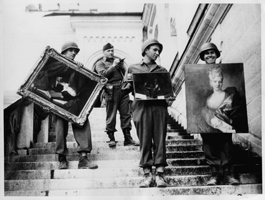home | metro santa cruz index | movies | current reviews | film review

Photo courtesy National Archives and Records Administration
The Restoration: Capt. James Rorimer, later the director of the Metropolitan Museum of Art, directs the safeguarding of art stolen from French Jews and discovered in a Bavarian castle.
Masterpiece Theater
'The Rape of Europa' tracks the massive Nazi heist of Europe's art
By Richard von Busack
We are now arriving at the Fuehrer Museum in Linz, Austria. It's the largest museum in the world, with mountainous neoclassical domes, one of the true highlights of Albert Speer's architectural career. Across from the monumental tomb of Hitler, this museum holds treasures appropriated from the Atlantic to the Urals: medieval altars from the Lowlands, the wealth of the Hermitage and the Louvre, sculptures and tapestries taken as spoils from every country the Nazis occupied.
The absorbing, extraordinarily good-looking and sweeping documentary The Rape of Europa shows us just how close this horror museum came to existing, and how the methodical looting by the Nazis is one of the least-discussed of their crimes. San Francisco documentary director Richard Berge and his partners Nicole Newnham and Bonni Cohen based their film on an adaptation of Lynn H. Nicholas' book of the same title.
The epic theft of Europe's art was accomplished by a mixture of barbaric greed and the urge to survive. Sometimes Europeans bartered their treasures for their lives. Commanders, especially Goering, considered themselves connoisseurs. The Reichsmarshall ended up with 1,700 masterworks by the time justice caught up with him.
The Nazi's looting was systematic; in advance of invasion they had shopping lists drawn up. The Rape of Europa shows how certain anonymous heroes whisked the Winged Victory and the Mona Lisa into hiding. Some kept clandestine, detailed records of the Nazi thefts. And after the war, a team of U.S. military art historians worked desperately to restore the stolen art to the nations and people to whom it belonged.
Berge, previously involved with KQED's local arts program Spark, is a former Angeleno and public television fan who wanted to make National Geographic documentaries when he grew up. He was a history major who minored in art history; after a detour through the insurance business he attended documentary school at Stanford.
I told him that The Rape of Europa seemed essentially dismaying. So much for the civilizing power of art, which seemed to leave the Nazis so untouched.
"That is an irony," Berge said. "On the happier side, the film is full of the stories of people who worked so hard to protect their patrimony. Would it happen here? You think of what art meant to the people of Florence, for example. If there were an invasion, would people in America take a week off from work to protect their national treasures?"
Enter "the Monument Men," the U.S. Army art experts who supervised the retrieval of the stolen art.
"There's more written about World War II than any other war," Berge said, "and yet this story hadn't been told. We wanted to get the Monument Men's stories on film before they passed away. And we knew the story would be interesting visually, not just because of the paintings, but the war footage."
Among many other stories, The Rape of Europa suggests the looting, burning and smashing of Europe's art was payback for Hitler's failure to be accepted to the Vienna art academy. If only the suffering bastard had emigrated to Chicago and turned his perfectly adequate artistic talents to the field of advertising, Hitler could have could have drawn burgermeisters and Bavarian cottages until his hands turned blue and then spent his evenings denouncing Jews at the country club.
The Rape of Europa premiered at the 2006 Boston Jewish Film Festival, and after special screenings at venues like the National Gallery in Washington, D.C., it played at the San Francisco International Film Fest. Currently, it's in its 11th week in San Jose. The documentary arrives in New York and Los Angeles this fall. The DVD release in mid-2008 will include stories left out of this version, including Army art historian Ken Lindsay's account of how he was ordered to pack up 200 paintings in five days—fragile masterpieces that needed special care—to send to the United States. The Monument Men signed a mass petition against this shipment, and then Lindsay realized that there was some intention to keep the work in the United States as spoils of war. According to Berge, "Lindsay tried to talk the then-director of New York MOMA out of the appropriation, and the director replied in turn. 'What are you, a bunch of sophomores? What did you think this war was about?'"
More than what was lost, The Rape of Europa shows us what was pieced together, like the Warsaw Palace in Poland, and what is still laboriously being re-created, like the Campobello in Pisa. This is a story of a massive and unthinkable assault, and of the gradual recovery afterward.
![]() THE RAPE OF EUROPA shows Thursday, Aug. 2, at 7pm at the Del Mar in Santa Cruz. Tickets are $15 and benefit the Cultural Council of Santa Cruz County. Regular showings start Aug. 10.
THE RAPE OF EUROPA shows Thursday, Aug. 2, at 7pm at the Del Mar in Santa Cruz. Tickets are $15 and benefit the Cultural Council of Santa Cruz County. Regular showings start Aug. 10.
Send a letter to the editor about this story.
|
|
|
|
|
|